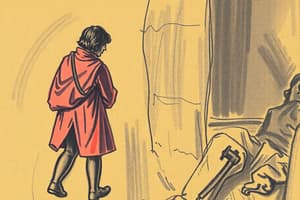Podcast
Questions and Answers
Match the following terms with their definitions:
Match the following terms with their definitions:
Perspective drawing = The art of representing three-dimensional objects on a two-dimensional surface Proportion = The correct relationship of size between two or more parts of an object Geometry = A suitable form of geometry; it represents figures and objects not as they are but as we see them in space Reality and appearance in perspective drawing = Drawing what you see from a specific viewpoint, not your idea or mental image of the subject
Match the following concepts with their explanations:
Match the following concepts with their explanations:
Geometry = Represents figures and objects not as they are but as we see them in space Perspective = The appearance of a distant object in relation to the observer's distance from it Perspective lines = Lines used to create the illusion of depth and distance in a drawing Foreshortened surface = Surface where objects appear shorter or compressed due to the angle of viewing
Match the following terms with their visual representation:
Match the following terms with their visual representation:
Rectangular table with parallel sides = Mental image of a table in a general sense Elliptical shapes on a converging, foreshortened surface = True appearance of dishes on a table from a specific viewpoint Proportionate objects = Objects with correct size relationship between their parts Perspective drawing from a specific viewpoint = Drawing representing the true appearance of objects in space
Match the following concepts with their role in perspective drawing:
Match the following concepts with their role in perspective drawing:
Match the following terms with their usage in perspective drawing:
Match the following terms with their usage in perspective drawing:
What is perspective drawing?
What is perspective drawing?
What is the difference between reality and appearance in perspective drawing?
What is the difference between reality and appearance in perspective drawing?
Why do children, beginners, and some sophisticated artists often draw objects with parallel sides?
Why do children, beginners, and some sophisticated artists often draw objects with parallel sides?
What is proportion in perspective drawing?
What is proportion in perspective drawing?
Define perspective lines in perspective drawing.
Define perspective lines in perspective drawing.
Flashcards are hidden until you start studying
Study Notes
Perspective Drawing Basics
- Perspective drawing is a technique used to create a 3D illusion on a 2D surface, making objects appear more realistic and lifelike.
Key Concepts and Definitions
- Perspective lines: lines that converge at a vanishing point, creating a sense of depth and distance in a drawing.
- Proportion: the relationship between the size of objects in a drawing, ensuring that they appear correctly scaled and realistic.
Reality vs. Appearance
- In perspective drawing, reality refers to the actual size and shape of objects, while appearance refers to how they are perceived by the viewer.
- The difference between reality and appearance lies in the way objects are distorted to create a sense of depth and distance.
Drawing Objects with Parallel Sides
- Children, beginners, and some sophisticated artists often draw objects with parallel sides because it is a natural tendency to draw objects as they really are, rather than how they appear to the viewer.
- This approach ignores the principles of perspective, resulting in a drawing that lacks depth and distance.
Perspective Drawing Techniques
- Perspective drawing involves using lines, shapes, and proportions to create a 3D illusion on a 2D surface.
- Techniques used in perspective drawing include creating a horizon line, establishing vanishing points, and using perspective lines to create a sense of depth and distance.
Studying That Suits You
Use AI to generate personalized quizzes and flashcards to suit your learning preferences.




